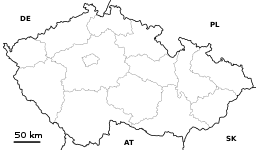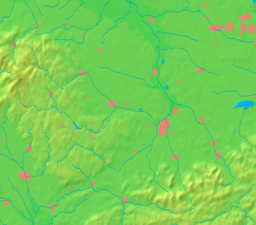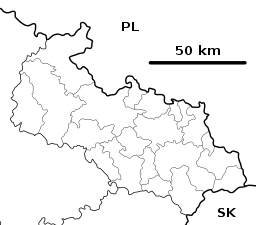Dolní Benešov
| Dolní Benešov | |||
| Town | |||
 Dolní Benešov over the Nezmar pond | |||
|
|||
| Country | Czech Republic | ||
|---|---|---|---|
| Region | Moravian-Silesian | ||
| District | Opava | ||
| Elevation | 231 m (758 ft) | ||
| Coordinates | 49°55′19″N 18°6′28″E / 49.92194°N 18.10778°ECoordinates: 49°55′19″N 18°6′28″E / 49.92194°N 18.10778°E | ||
| Area | 14.8 km2 (5.7 sq mi) | ||
| Population | 4,203 (2012-01-01) | ||
| Density | 284/km2 (736/sq mi) | ||
| Mayor | Martin Štefek | ||
| Timezone | CET (UTC+1) | ||
| - summer (DST) | CEST (UTC+2) | ||
| Postal code | 747 22 | ||
  Location in the Czech Republic | |||
  Location in the Moravian-Silesian Region | |||
| Wikimedia Commons: Dolní Benešov | |||
| Website: www.dolnibenesov.cz | |||
Dolní Benešov (Czech pronunciation: [ˈdolɲiː ˈbɛnɛʃof]; German: Beneschau) is a small town in the Moravian-Silesian Region of the Czech Republic. It was first mentioned in a 1312 deed as an estate of the Benešovice noble family and received town privileges in 1493 by King Vladislaus II of Bohemia. On a ca. 1588 map of Poland and Silesia by G. Mercator it is spelled Benischaw, and spelled Benischow on a ca. 1688 map by N.S. D'Abbeville. The original family name was likely spelled Benis, with the suffix -chaw or -chow meaning domain or town. In an 1812 reference book (A System of Geography, Ancient and Modern by James Playfair, Hill, p. 695) it is spelled Benischau, with a German suffix. On an 1880 map of Silesia it is spelled Beneschau. In 1846 Salomon Mayer Rothschild, who owned the ironworks in nearby Vítkovice, acquired Benešov Palace, probably then spelled Palace Benisowa (of the Benis family).[1]
During WWII, the village, then still known locally as Beneschau, was the base for a working party (E444) of British and Commonwealth prisoners of war, under the administration of Stalag VIIIB/344 at Łambinowice (then known as Lamsdorf) in Poland. In January 1945, as the Soviet armies resumed their offensive and advanced from the east, and the prisoners were marched westward in the so-called Long March or Death March. Many of them died from the bitter cold and exhaustion. The lucky ones got far enough to the west to be liberated by the Allied armies after some four months of travelling on foot in appalling conditions.[2][3][4]
Today, Dolní Benešov has about 4,300 inhabitants; it is a part of the Hlučín Region.
Authority
The city’s municipal office is a mixed community. They serve at the same time as the office of a city council or city council, and as an administrative office performing delegated state administration. The administrative authority is a public authority, which is legally entrusted with limited competence in the field of state administration.
Culture and sports
The town of Dolní Benešov is rich in cultural and sporting events, both traditional and modern. There are a large number of interest clubs and sports clubs in the city; it also provides local clubs and associations with a sufficient background for their activities.
International relations
Twin towns — sister cities
Dolní Benešov is twinned with:
External links
- (in Czech) Official website
Gallery
 Sunset over Nezmar in Dolní Benešov
Sunset over Nezmar in Dolní Benešov
References
| Wikimedia Commons has media related to Dolní Benešov. |

